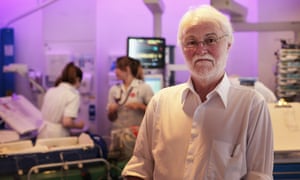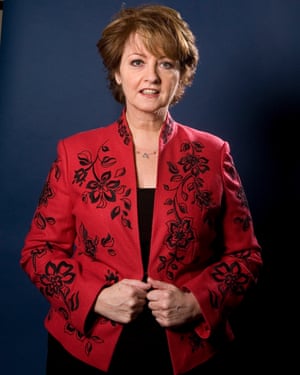Parenting manuals have a lot to answer for. They brought useful advice and reassurance, true. But along with those came an epidemic that killed tens of thousands of babies. Sudden infant death syndrome – Sids – is always a tragedy, but it is no longer commonplace. It became an epidemic between 1970 and 1991, and, at its peak, babies in some of the world’s richest countries were dying at the rate of one in every 250 live births each year. The rate in the last year for which figures were available in England and Wales only, 2013, is one in every 3,000.
The Back to Sleep campaign, launched in 1991, changed the advice on sleeping position from front to back, and has had a public health benefit comparable to such breakthroughs as the moment Victorian epidemiologist John Snow took the handle off the Soho water pump in 1854 and stopped a cholera outbreak in its tracks.
At the centre of the Sids revolution was Bristol doctor Peter Fleming. He is now semi-retired, but is currently exploring a link between subtle features of the newborn hearing test and arousal mechanisms that might answer the grievous unsolved riddle of why Sids happens.
In 1978 Fleming, who had qualified in Bristol, returned from a job at the Toronto children’s hospital in Canada with funding from the US National Institutes of Health that enabled him to set up his own respiratory lab. He wanted to look in particular at the relationship between breathing and temperature control in infants.

Fleming is both very clever – he has a PhD in nonlinear mathematical modelling, AKA chaos theory – and very humane. When he found that Bristol offered no counselling or support for families whose baby had died unexpectedly, he began to offer it himself. He saw the families in the emergency department and later in their homes and told them what was known – and how much was unknown – about what was then still widely called cot death.
“Lots of people still thought that the parents must be at fault in some way if their baby had died. They were made to feel very guilty. I wanted to get support, and information, to these families.”
The progress in public understanding is reflected in the change of terminology. When it was called cot death it was considered primarily a social problem, a parental failure that still carried a hint of the most unnatural of crimes, infanticide. When it became sudden infant death syndrome (or sudden unexplained/unexpected infant death syndrome, SUID), it became a medical problem that was capable of scientific resolution.
Early in the 1970s, a US congressional committee called it “one of the last great unresolved childhood catastrophes” and announced federal funding. Meanwhile, bereaved parents were organising too. In 1971 the Foundation for the Study of Infant Deaths was set up in the UK by a grandmother determined to explain her grandson’s death. (It recently rebranded itself as The Lullaby Trust, because it believed its previous name was too austere and off-putting.) A decade later there was an international federation of similar organisations. In 1984, Fleming, working closely with the trust, set up the Avon infant mortality programme.
“I didn’t look at the sleeping position. But in 1987, with two colleagues, I started a temperature and infection study, and we did include the sleeping position, because scientists in the Netherlands and Australia had no data but they did have a lot of careful observation that made them think it was important.” Far from starting his study in equipoise, with a mind open to every possibility, Fleming only considered the sleeping position question in order to exclude it.
There were no immediately definitive results. “It was incremental. Very few things are ever black and white. It is rarely clear-cut. It is about changing the risk,” Fleming says. This is why the maths matters. “You have to try to understand complexity. You have to see whether a small change can make a difference.”
It helped that, like many of the Bristol families whose experiences were central to Fleming’s research, he came from a working-class family. He grew up in Medway in Kent, where his father worked in the naval dockyard and his mother in the office of a local factory.
For his study, Fleming and his team talked to the bereaved families as soon as possible after the death, to gather information about the baby and the family, what they normally did, what might have been different – all the variables that might have influenced the outcome. He promised the families that they would know the results of his research before it was published: “It’s really important that the people involved feel they own the work. It is a collaborative effort. I want to work with people, not instruct them.”
GPs, midwives and health visitors were all involved. If a GP got a call about a dead or an unresponsive baby, their next call would be to Fleming. “I spent a lot of time with just-bereaved families in council houses. It didn’t bother me, because I was not inclined to see them as different from myself.”
Over the next two years, he and his team gathered data from 70 bereaved families, and from another 140 families whose babies had been born very close to the time of a Sids baby. The control group were identified by asking the health visitor for the details of the two babies next on their list. They were “the babies next door”. “There was 99% collaboration from the families,” Fleming said. “People were very, very positive about wanting to do something.”
The team was confident that their population-based study, with a control group drawn from the same population, at the same time, was as close as possible to achieving the holy grail of true comparability. Yet despite their confidence in the robustness of their data, presenting the preliminary results at the first ever meeting of the International Society for the Prevention and Investigation of Perinatal and Infant Deaths in March 1989 was a nerve-racking moment. Fleming’s findings were received by his knowledgeable audience with incredulity. “They could not accept that something so simple could be so important,” he says.
It was like being asked to believe two impossible things before breakfast. Here was a non-medical intervention that could, for no clear reason, stop babies dying of a syndrome that was also unexplained. But Fleming believed it himself. And when he went back to do a bigger study in Bristol, he found that health professionals who already knew of his findings were advising all new mothers to put their babies on their back to sleep.
Understandably, bereaved families whose babies died after Fleming’s first study believe his results should have been publicised at once. But “Nice [the National Institute for Health and Care Excellence] would have laughed at my research. They want things done properly – randomised control trials and all that sort of thing. It wasn’t enough to convince scientific colleagues, and it certainly wouldn’t meet the standards for any public health campaign,” he says.
Fleming published his paper in the British Medical Journal and went back to do more research. Soon, a New Zealand study [pdf download] produced similar findings. The quest now was for evidence with which to argue for a new public health campaign. Unable to conduct a study with a bigger sample in Bristol because newborns were no longer being put to sleep on their fronts as a result of his first findings, instead Fleming found himself conducting a self-initiated, population-wide observational study of newborn babies sleeping on their backs. As his first study predicted, the number of Sids deaths fell from around one a week to less than one a month, and then to just three a year. While he was in the midst of the long process of getting this study published in the Lancet, another family’s tragedy tipped the whole project into the headlines.

In July 1991, Sebastian, the four-month-old son of Anne Diamond – then a household name with a daily TV show – died in his cot. Diamond’s response was to use all her fame and journalistic experience to investigate what people knew about why it had happened. When she met Fleming, and learned of the findings in the Avon and New Zealand studies, she marched on the Department of Health.
She galvanised the health secretary, Viriginia Bottomley, into accepting the need for a strong public health message. In December 1991 the Back to Sleep campaign was launched. Sids deaths in the UK fell instantly, and with astonishing speed. In 1989 there were 1,545 Sids deaths. Now there are barely 200 a year.
The Sids epidemic can be dated from the time it first appeared on death certificates in 1970, until the public health campaign in 1991. In Britain alone, it probably cost 10,000 lives. It is still hard to explain how it happened. The first recorded advice to put babies to sleep on their front is from 1943. Dr Spock changed his advice to recommend front sleeping between the first and second editions of his famous handbook in 1955.
Some studies associate the syndrome with the rise of the parenting expert, others with the industrialisation of baby care that turned it into a round of bottle-feeding and rigid routines. Others point to the fading respect for culture and experience. The only medical evidence for the benefit of front sleeping came from studies of very premature babies who are still put face down; but even they are never now sent home until they can breathe well enough to prosper on their backs. It was a tragic lesson in the danger of taking a small, sick subset of a population and extrapolating a public health message for well babies.
The architectural writer Gillian Darley lost her son Joseph when he was 11 weeks old, during a midday sleep on a cold, murky day in early April nearly 30 years ago. “I was visiting a friend. He was in his moses basket. I don’t remember being told what to do, it was just what everyone did,” she says. “It was received wisdom. The underlying thing is – like those terrible stories of children who disappear on their gap year and whose bodies are never found – the lack of closure. It’s not a constant presence, but if it was possible to say what was the trigger, it would take a whole load off my subconscious.”
Understanding that trigger is no closer. But the risk factors are now well understood: maternal smoking and co-sleeping. No one questions the former. Co-sleeping, however, has become the subject of intense controversy, not least because warnings of the dangers of taking babies into their parents’ beds has led some mothers to choose instead to nurse babies on sofas, where accidents such as suffocation are more likely. Fleming believes the direct risk from co-sleeping is very small, but the Lullaby Trust takes the view that, like advertising, public health cannot do complexity, and so continues to warn against co-sleeping.
Sids was once a curse that struck randomly across classes. Now it hits in wildly disproportionate numbers the poorest, least-educated families. More than 70% of deaths now occur in poor households, and often to young mothers.
Francine Bates, Lullaby’s chief executive, says that justifies sticking to one clear, simple message: don’t smoke, don’t co-sleep.
“It’s fundamentally wrong and preventable that it’s poor babies who are dying now,” she says. “It’s unacceptable. We’ve still got a job of work to do. Behind the statistics, there are still hundreds of babies, and hundreds of devastated families.”
Back to sleep: the doctor who helped stem a cot death epidemic
Hiç yorum yok:
Yorum Gönder